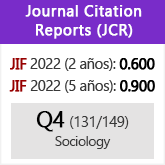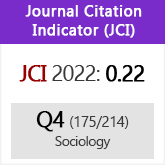Cuando las personas obesas son más pacientes que las personas no obesas. Un estudio post-quirúrgico de individuos en una asociación de pérdida de peso
DOI:
https://doi.org/10.3989/ris.2011.05.04Palabras clave:
Descuento temporal, economía experimental y del Comportamiento, ObesidadResumen
El objetivo principal de este artículo es investigar las tasas de descuento temporal entre los individuos obesos tratados quirúrgicamente y que pertenecen a una asociación de personas interesadas en controlar su peso. también se analiza si el nivel socio-económico y los rasgos de la personalidad explican las diferencias existentes. las tasas de descuento diferido se obtuvieron utilizando los incentivos monetarios reales en un experimento económico donde a los sujetos se les pide elegir entre una menor y más inmediata recompensa o una recompensa mayor diferida. los rasgos de personalidad son examinados usando el modelo de cinco factores. Curiosamente, nuestros resultados muestran que las personas obesas muestran tasa de descuento menores al grupo de referencia. estas diferencias no pueden explicarse por los rasgos de personalidad. Nosotros sostenemos que la gente obesa no debería mostrar mayores tasas de descuento. De hecho, la conciencia y el compromiso, en lugar de su actual índice de masa corporal, parecen jugar un papel más importante en la determinación de este parámetro.
Descargas
Citas
Baldaro, B., Rossi, N., Caterina, R., Codispoti, M., Balsamo, A. and Trombini, G., 2003. “Deficit in the discrimination of nonverbal emotions in children with obesity and their mothers.” International Journal of Obesity and Related Metabolic Disorders 27: 191–195. http://dx.doi.org/10.1038/sj.ijo.802228 PMid:12586998
Baskin, M. L., Ard, J., Franklin, F., and Allison, D. B., 2005. “Prevalence of obesity in the United States.” Obesity Review, 6: 5–7. http://dx.doi.org/10.1111/j.1467-789X.2005.00165.x PMid:15655032
Borghans, L., and Golsteyn, B. H. H., 2006. “Time discounting and body mass index, evidence from the Netherlands.” Economics of Human Biology 4: 39–61. http://dx.doi.org/10.1016/j.ehb.2005.10.001
Camerer C. and Ho T., 1994. “Violations of the betweenness axiom and nonlinearity in probability.” Journal of Risk and Uncertainty 8: 167-196. http://dx.doi.org/10.1007/BF01065371
Chapman, G., Brewer, N., Coups, E., Brownlee, S., Leventhal, H., and E. Leventhal. 2001. “Value for the future and preventative health behavior.” Journal of Experimental Psychology 7(3): 235-250.
Coller M. and M. B. Williams.1999. “Eliciting Individual Discount Rates.” Experimental Economics 2:107-27. http://dx.doi.org/10.1007/BF01673482
Costa, Paul T. and R. McCrae. 1992. “Four Ways Five Factors are Basic.” Personality and Individual Differences 13(6): 653-65. http://dx.doi.org/10.1016/0191-8869(92)90236-I
Cutler, D. and E. Glaeser. 2005. “What explains differences in smoking, drinking and other healthrelated behaviors?.” Paper Number 2060. Harvard Institute of Economic Research Discussion
Cutler D., Glaeser E., and J. Shapiro. 2003. “Why have Americans become more obese?” Journal of Economic Perspectives 17(3): 93-118. http://dx.doi.org/10.1257/089533003769204371
Digman, JM. 1990. “Personality Structure: Emergence of the Five-Factor Model. Annual Review of Psychology 41: 417-40. http://dx.doi.org/10.1146/annurev.ps.41.020190.002221
Dohmen, T., Falk, A., Huffman, D. and Sunde, U. 2010. “Are Risk Aversion and Impatience Related to Cognitive Ability?.” American Economic Review, 100(3): 1238-60. http://dx.doi.org/10.1257/aer.100.3.1238
Elfhag K., and Lundh L-G. 2007. “TAS-20 alexithymia in obesity, and its links to personality Scandinavian.” Journal of Psychology 48:391-398.
Frederik S., G. Loewenstein and O’Donoghue T. 2002. “Time Discounting and Time Preferences: A Critical Review.” Journal of Economic Literature 40(2):351-401. http://dx.doi.org/10.1257/002205102320161311
Green, L., Fry, A. F., and Myerson, J. 1994. “Discounting of delayed rewards: A life-span comparison.” Psychological Science 5:33-36. http://dx.doi.org/10.1111/j.1467-9280.1994.tb00610.x
Harrison G.W., Morten L., & Williams M.B., 2002. “Estimating Individual Discount Rates for Denmark: A Field Experiment.” American Economic Review 92(5):1606-1617. http://dx.doi.org/10.1257/000282802762024674
Hertwig, R., and Ortmann, A., 2001. “Money, lies, and replicability: On the need for empirically grounded experimental practices and interdisciplinary discourse.” Behavioral and Brain Sciences 24:433-451.
Hirsh JB., Morisano D. and Peterson JB. 2008. “Delay discounting: Interactions between personality and cognitive ability.” Journal of Research in Personality 42:1646-1650. http://dx.doi.org/10.1016/j.jrp.2008.07.005
John, O.P. and Srivastava S. 1999. “The Big Five Trait Taxonomy: History, Measurement and Theoretical.” Pp. 102-38 in Handbook of Personality: Theory and Research, edited by Lawrence A. Pervin and Oliver P. John. New York: The Guilford Press.
Johnson, M. W., and Bickel, W. K. 2002. “Within-subject comparisons of real and hypothetical monetary rewards in delayed discounting.” Journal of Experimental Analysis of Behavior 77:129-146. http://dx.doi.org/10.1901/jeab.2002.77-129 PMid:11936247 PMCid:1284852
Komlos J., Smith P. and Bogin B. 2004. “Obesity and the rate of time preference: is there a connection?” Journal of Biosocial Science 36(2):209-219. http://dx.doi.org/10.1017/S0021932003006205 PMid:15030016
Madden, G. J., Begotka, A. M., Raiff, B. R., and Kastern, L. 2003. “Delay discounting of real and hypothetical rewards.” Experimental & Clinical Psychopharmacology 11:139-145. http://dx.doi.org/10.1037/1064-1297.11.2.139 PMid:12755458
Nederkoorn, C., Smulders, F., Havermans, R., Roefs, A., and Jansen, A. 2006. “Impulsivity in obese women.” Appetite 47: 253-256. http://dx.doi.org/10.1016/j.appet.2006.05.008 PMid:16782231
Ogden, C. L., Carroll, M. D., Curtin, L. R., McDowell, M. A., Tabak, C. F., and Flegal, K. M. 2006. “Prevalence of overweight and obesity in the United States.” The Journal of the American Medical Association 295:1549-1555. http://dx.doi.org/10.1001/jama.295.13.1549 PMid:16595758
Philipson T., 2001. “The world-wide growth in obesity: an economic research agenda.” Health Economics, 10(1):1-7. http://dx.doi.org/10.1002/1099-1050(200101)10:1<1::AID-HEC586>3.0.CO;2-1
Pinaquy, S., Chabrol, H., Simon, C., Louvet, J. P. and Barbe, P. 2003. “Emotional eating, alexithymia, and binge-eating disorder in obese women.” Obesity Research 11:195-201. http://dx.doi.org/10.1038/oby.2003.31 PMid:12582214
Reynolds, B., Ortengren, A., Richards, J. B., and De Wit, H. 2006. “Dimensions of impulsive behavior: Personality and behavioral measures.” Personality & Individual Differences 40:305-315. http://dx.doi.org/10.1016/j.paid.2005.03.024
Rydén, A., Sullivan, M., Torgerson, J.S., Karlsson, J., Lindroos, A-K. and Taft, C. 2004. “A comparative controlled study of personality in severe obesity: a 2-y follow-up after intervention.” International Journal of Obesity 28:1485-1493. http://dx.doi.org/10.1038/sj.ijo.0802768 PMid:15356662
Shamosh, N.A.. and Gray, J.R. in press. “Delay discounting and intelligence: A meta-analysis.” Intelligence, 10.1016 / j.intell. 2007.09.004.
Smith, P.K., Bogin, B., and Bishai, D., 2005. “Are time preference and body mass index associated? Evidence from the National Longitudinal Survey of Youth.” Economics and Human Biology 3:259-270. http://dx.doi.org/10.1016/j.ehb.2005.05.001
Sullivan S., Cloninger, C.R., Przybeck, T.R., and Klein, S., 2007. “Personality characteristics in obesity and relationship with successful weight loss.” International Journal of Obesity 31:669-674.
Terracciano, A., Löckenhoff, C.E., Crum, R.M., Bienvenu, O.J. and Costa, P.T. Jr. 2008. “Five-Factor Model personality profiles of drug users.” BMC Psychiatry 8:22. http://dx.doi.org/10.1186/1471-244X-8-22 PMid:18405382 PMCid:2373294
Robles, E., Vargas, P.A. and Bejarano, R. 2009. “Within-subject differences in degree of delay discounting as a function of order of presentation of hypothetical cash rewards.” Behavioural Processes (81)2:260-263. http://dx.doi.org/10.1016/j.beproc.2009.02.018 PMid:19429219
Weller, R.E., Cook II, E., Avsar, K., and Cox, J., 2008. “Obese women show greater delay discounting than healthy-weight women.” Appetite 51:563-569. http://dx.doi.org/10.1016/j.appet.2008.04.010 PMid:18513828
WHO. 2002. The world health report 2002 - Reducing Risks, Promoting Healthy Life.
WHO. 2003. Diet, Nutrition, and the Prevention of Chronic Diseases. WHO Technical Report 916.
Wyatt, S.B., Winters, K.P. and Dubbert, P.M. 2006. “Overweight and obesity: Prevalence, consequences, and causes of a growing public health problem.” American Journal of Medical Science 331:166-174. http://dx.doi.org/10.1097/00000441-200604000-00002 PMid:16617231
Zhang, L. and Rashad, I., 2008. “Obesity and time preference: The health consequences of discounting the future.” Journal of Biosocial Sciences 40:97-113. http://dx.doi.org/10.1017/S0021932007002039 PMid:17517169
Descargas
Publicado
Cómo citar
Número
Sección
Licencia
Derechos de autor 2012 Consejo Superior de Investigaciones Científicas (CSIC)

Esta obra está bajo una licencia internacional Creative Commons Atribución 4.0.
© CSIC. Los originales publicados en las ediciones impresa y electrónica de esta Revista son propiedad del Consejo Superior de Investigaciones Científicas, siendo necesario citar la procedencia en cualquier reproducción parcial o total.Salvo indicación contraria, todos los contenidos de la edición electrónica se distribuyen bajo una licencia de uso y distribución “Creative Commons Reconocimiento 4.0 Internacional ” (CC BY 4.0). Puede consultar desde aquí la versión informativa y el texto legal de la licencia. Esta circunstancia ha de hacerse constar expresamente de esta forma cuando sea necesario.
No se autoriza el depósito en repositorios, páginas web personales o similares de cualquier otra versión distinta a la publicada por el editor.

















